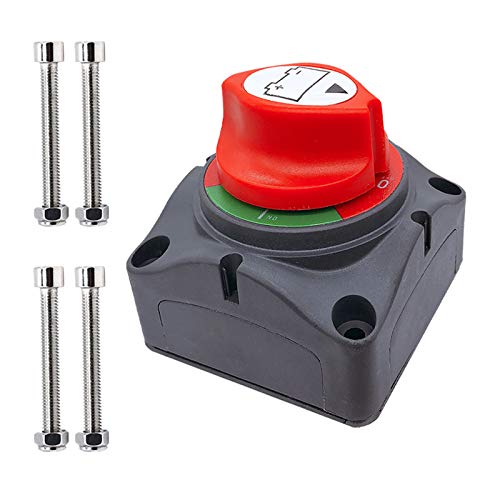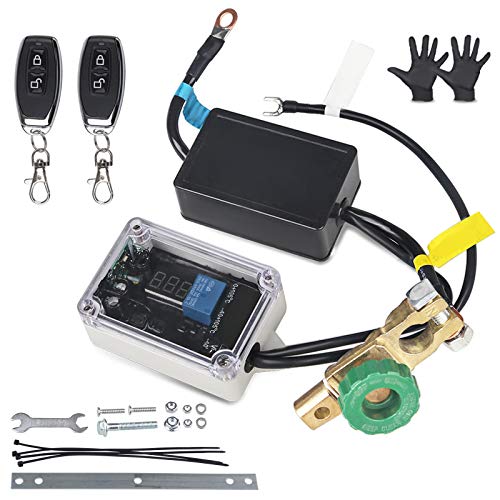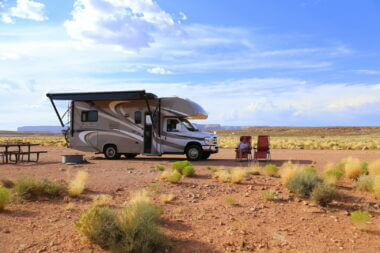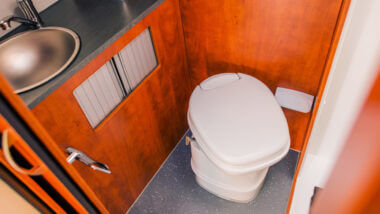Table of Contents Show
The ability to readily charge our RV house batteries is one of the most coveted bits of engineering genius available to RVers. Safety and the preservation of those batteries lead to long-term performance, and the battery disconnect switch plays a significant role in that.
But how do these power controllers work, when should we use them, and which are best? Let’s find out!
What Is a Battery Disconnect Switch?
Simply stated, a battery disconnect switch is an easy and convenient way to cut off electrical power to a circuit. They provide a safety mechanism, such as when you’re working on your RV’s electrical components.
They also protect the battery and keep it from draining when connected but not in use. Otherwise, the inevitable slow drain impacts the overall health and longevity of your power storage.
How Does a Battery Disconnect Switch Work?
A battery disconnect switch sits between the negative battery terminal and cable. It severs the connection between the RV’s battery and the 12-volt fuses throughout the RV to power various areas and amenities.
Engaging the switch cuts the power flow to the negative battery cable, thus cutting off power to all 12-volt receptacles and appliances throughout the RV. When turned off, the switch allows power to resume.
Many RVs come with battery disconnect switches, but installing one is not especially complicated for those that don’t. It’s important, however, to use one that’s rated for your vehicle’s battery.
When Would You Use an RV Battery Disconnect Switch?
A battery disconnect switch is helpful whenever you’re performing electrical maintenance, repairs, or modifications to your RV. The ability to disconnect power to the 12-volt circuits by simply flipping the switch makes for a safer and more efficient process.
They are also useful when storing your RV long-term or even for just a few weeks. In this case, the switch would prevent constant battery drainage from parasitic loads such as electronic circuit boards and computers, clocks, LP gas (propane), alarms, radios, a TV antenna boost, or even a 12-volt light that you may have left on.
It’ll also save you from a vehicle that won’t start due to a drained engine battery!
Best RV Battery Disconnect Switches
Now that we understand what a battery disconnect switch is, how it works, and when to use it, let’s investigate a few of the best RV power controls on the market today!
1. Ampper Battery Disconnect Switch
- Heavy Duty: ABS plastic housing, durable made for safety use, rear cover insulates terminals against any short of...
- Specification: On/Off 2 positions, 275 A continuous at DC 12V, 455 A intermittent at DC 12V, 1250 A momentary at DC 12V.
This Ampper switch is very inexpensive yet effective and is appropriate for RVs, cars, and boats. It’s an easy-to-use rotary switch that’s also easy to read–red means “off” (power off), green is “on” (power flowing).
This switch is a heavy-duty ABS plastic square that can be securely seated with four provided long bolts. It has a copper terminal stud and a rear cover that insulates the terminals against short circuits and side pads to prevent dust and dirt from entering the terminal area.
Ampper states that this switch is rated for 275A (Amps) continuous at DC 12V, 455A Intermittent at DC 12V, and 1250A momentary at DC 12V. It also offers a universal fit for DC 12 – 48V systems.
2. Ampper Battery Disconnect Switch with Key
- Specification: used for DC 12-24 V systems, On/Off 2 position, rated current: 100A (12V ), Max. withstanding current:...
- Heavy Duty: ABS plastic and solid brass nuts / washers, rust and corrosion resistant, durable made for safety use.
The Ampper Battery Disconnect Switch with Key is almost half the cost of Ampper’s rotary dial switch but operates differently. This product includes two keys (one is a spare) and a cover, all made of plastic.
The key locks the contacts together when the switch is “on” (power is flowing). When “on,” you can’t remove the key.
However, when the switch is in the “off” position, you can take out the key. This would disable an engine battery, for instance, serving as a theft-prevention device. The kit comes with a waterproof cover to protect the keyhole when empty.
This switch can handle currents up to 100 Amps. Note that max current is rated at only 150A for 5 seconds.
This tool is appropriate for DC 12 – 24 V systems which are standard in most RVs.
3. Wireless Remote Controlled Battery Disconnect Switch
- 1.This is a More Convenient Car Battery Disconnect Switch System that can remotely master kill your car power system,A...
- 2.It does not need to be removed the green button under normal use of the remote control.Connected to the Battery...
For those seeking a much higher-end battery disconnect switch, this ADPOW wireless remote-controlled unit is an option. This automatic or manual switch works with a rotary screw-down. When you tighten the screw, power flows, and when you loosen it, it disengages the power.
You can also use a remote control to operate this unit from 320 feet away!
ADPOW also advertises this unit as universal for any 12V power system, noting that it has a low-voltage automatic power-off feature. If you connect the included voltmeter to your 12V system, you can monitor the battery’s condition in real-time. It offers an LED read-out that gives information about your battery state.
Battery Disconnect Switches: A Useful Addition to Your RV
While there are many battery disconnect switches from which to choose, it’s easy to decide whether or not to install one. These ones are inexpensive and simple to install while adding valuable safety, convenience, and battery preservation measures. Once you install one, you’ll never want to go without one!
Last update on 2025-01-19 / Affiliate links / Images from Amazon Product Advertising API










Twice, I have installed a Battery Disconnect Switch with Key, in the lid of my battery box and both tines the switches have failed. Usually one of the terminals on the switch is corroded. What can I do to keep the switches from failing?